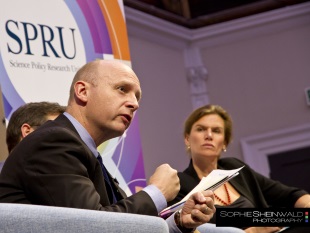The Science Policy Research Unit (SPRU) at the University of Sussex will soon be celebrating 50 years as a hub of research into innovation.

What is innovation policy for?
The Director of SPRU, Johan Schot—who has pipped me to the first post-conference blog post—kicked off by putting innovation policy in the context of broader global trends. What effect will power shifts away from the national level and from West to East have? Will innovation help us develop more sustainable supply chains?
Governments spend billions on policies to support innovation, but Schot said these have too often taken a ‘technology push’ approach. Innovation policy can aid transformative change, but needs to represent societal needs to do this. Professor Sandy Thomas added that we need to move beyond an “innovation first, regulation second” approach and ask the question: innovation for who, and by whom?
Frugal innovation from the margins
We often think about innovations that come from research labs, so Charles Leadbeater’s talk about ‘the frugal innovator’ added breadth to the discussion. He saw innovation as key to raising living standards within severe constraints on resources, and talked about lean, simple and social innovations being developed in the margins and extremes, where they are driven by necessity and constraints.
Husk Power Systems turn waste products into energy in rural areas and Madhav Chavan found a way to educate children for $10 a year in India. These solutions have come from bright ideas without much resource, but Sally Uren from Forum for the Future identified a key issue, how do we grow these innovations to scale?
Liam Byrne meets Mariana Mazzucato…
All of this warmed us up for the headline act, a conversation between Rt. Hon. Liam Byrne MP, the shadow Minister for Universities, Skills and Science and Professor Mariana Mazzucato, RM Phillips Professor of Science and Technology Policy at SPRU.
For Byrne, innovation can help to answer the ‘cost of living crisis’, which is shaping up to be the central narrative of Labour’s 2015 election campaign. Byrne focussed on building an optimistic vision for the future of the UK, with a knowledge economy, quality jobs “and more ladders to them”, at its heart.
Mazzucato outlined the key arguments from her book, The Entrepreneurial State. Although innovation policy often aims to fix market failures, Mazzucato outlined a more active role for a confident Government in shaping and creating markets, as well as providing a direction for technology development. She suggested that ‘greening the economy’ was an obvious choice.
How can the UK be more innovative?
These starting points framed a heated discussion. Byrne cautioned that the UK is a small nation in a competitive, global economy, but Mazzucato was clear that the size of a nation does not determine its ability to innovate and compete. She pointed to Danish firms dominating supply of renewable energy services to China.
Can Government itself be innovative? Mazzucato thinks so, pointing to the Government Digital Service that built the much lauded gov.uk site. However, Byrne saw this as an exception, with the civil service being generally bad at innovation. Charles Leadbeater also challenged Mazzucato’s characterisation of Government as a single entity; it is in fact a collection of organisations with different cultures and capacities for innovation.
What lessons for future innovation policy?
Science and innovation can help us meet complex societal challenges, and making the right policies can help this process. The afternoon’s discussions pointed to some factors that can promote innovation, such as working within constraints or setting clear goals. At the same time, future policies should try to create space for consideration of which innovations we want or need at the outset, rather than playing catch up.
